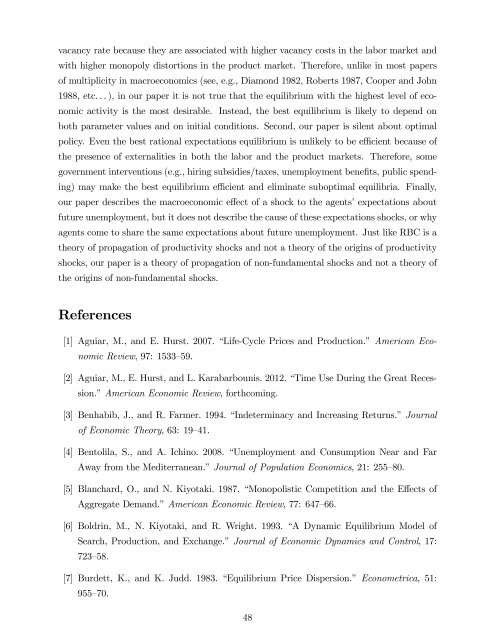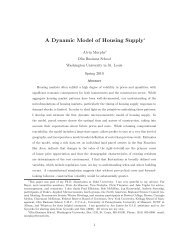Shopping Externalities and Self Fulfilling Unemployment Fluctuations*
Shopping Externalities and Self Fulfilling Unemployment Fluctuations*
Shopping Externalities and Self Fulfilling Unemployment Fluctuations*
You also want an ePaper? Increase the reach of your titles
YUMPU automatically turns print PDFs into web optimized ePapers that Google loves.
vacancy rate because they are associated with higher vacancy costs in the labor market <strong>and</strong>with higher monopoly distortions in the product market. Therefore, unlike in most papersof multiplicity in macroeconomics (see, e.g., Diamond 1982, Roberts 1987, Cooper <strong>and</strong> John1988, etc. . . ), in our paper it is not true that the equilibrium with the highest level of economicactivity is the most desirable. Instead, the best equilibrium is likely to depend onboth parameter values <strong>and</strong> on initial conditions. Second, our paper is silent about optimalpolicy. Even the best rational expectations equilibrium is unlikely to be e¢ cient because ofthe presence of externalities in both the labor <strong>and</strong> the product markets. Therefore, somegovernment interventions (e.g., hiring subsidies/taxes, unemployment bene…ts, public spending)may make the best equilibrium e¢ cient <strong>and</strong> eliminate suboptimal equilibria. Finally,our paper describes the macroeconomic e¤ect of a shock to the agents’expectations aboutfuture unemployment, but it does not describe the cause of these expectations shocks, or whyagents come to share the same expectations about future unemployment. Just like RBC is atheory of propagation of productivity shocks <strong>and</strong> not a theory of the origins of productivityshocks, our paper is a theory of propagation of non-fundamental shocks <strong>and</strong> not a theory ofthe origins of non-fundamental shocks.References[1] Aguiar, M., <strong>and</strong> E. Hurst. 2007. “Life-Cycle Prices <strong>and</strong> Production.” American EconomicReview, 97: 1533–59.[2] Aguiar, M., E. Hurst, <strong>and</strong> L. Karabarbounis. 2012. “Time Use During the Great Recession.”AmericanEconomic Review, forthcoming.[3] Benhabib, J., <strong>and</strong> R. Farmer. 1994. “Indeterminacy <strong>and</strong> Increasing Returns.” Journalof Economic Theory, 63: 19–41.[4] Bentolila, S., <strong>and</strong> A. Ichino. 2008. “<strong>Unemployment</strong> <strong>and</strong> Consumption Near <strong>and</strong> FarAway from the Mediterranean.”Journal of Population Economics, 21: 255–80.[5] Blanchard, O., <strong>and</strong> N. Kiyotaki. 1987. “Monopolistic Competition <strong>and</strong> the E¤ects ofAggregate Dem<strong>and</strong>.”American Economic Review, 77: 647–66.[6] Boldrin, M., N. Kiyotaki, <strong>and</strong> R. Wright. 1993. “A Dynamic Equilibrium Model ofSearch, Production, <strong>and</strong> Exchange.” Journal of Economic Dynamics <strong>and</strong> Control, 17:723–58.[7] Burdett, K., <strong>and</strong> K. Judd. 1983. “Equilibrium Price Dispersion.” Econometrica, 51:955–70.48
















